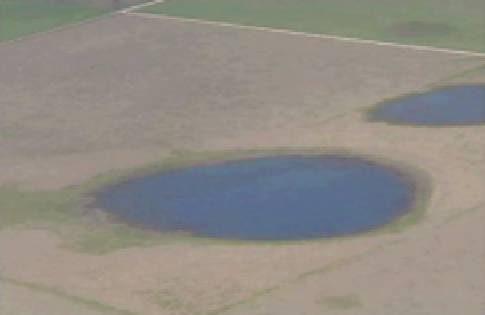Environmental Engineering Reference
In-Depth Information
FIGURE 9.11
Playa Lake in the Texas Panhandle. (Photograph courtesy of Texas Parks and Wildlife
Department © 2013.)
9.3.1.4 Solution Basins
These basins are formed when solution caves collapse. Solution lakes are very common in limestone
regions, as illustrated by the many solution lakes in Indiana, Kentucky, Tennessee, Florida (Wetzel
2001), and the Yucatan Peninsula in Mexico. In North America, Florida has the largest concentra-
tion of solution lakes. Examples include doline lakes, which are collapse sinkholes, and karst lakes,
which are limestone sinks.
9.3.1.5 Wind Basins
These basins are located in arid regions where the soil is ine and the wind creates a depression.
Playa lakes, common in the arid regions of the United States and Kinjiang Province in Western
China, result from wind erosion as it forms large pans on nearly level soils. Playa lakes are com-
mon in the U.S. Great Plains, and are often one of the few sources of water there. They are heav-
ily used by migrating waterfowl. According to the Texas Parks and Wildlife Commission, there
are over 19,000 playa lakes in the Texas Panhandle, averaging slightly more than 15 acres in size
(Figure 9.11). The lakes often go through extended wet and dry cycles.
9.3.1.6 Stream Basins
These basins include luvial lakes, which form as a result of stream deposition or erosion, as with
the simple expansion in the width of a river, behind deposits or obstructions in streams, or when two
rivers of different velocities meet and have a buildup of materials at their conluence. Plunge-pool
lakes form from erosion below waterfalls, such as the Grand Coulee Lake in Washington. Oxbow
lakes are formed with the cutoff of a stream meander and are common along many of our major
river systems, such as the lower Mississippi River (e.g., Figure 9.12).
There are many other types of natural lake basins. For example, G.E. Hutchinson (1957) listed 76
types of lakes based on their geomorphological characteristics. However, the classiication provided
in this section some indication of the diversity of lakes that may occur.
9.3.2 r
eSerVoIrS
In addition to naturally occurring basins, there are man-made basins. Reservoirs are mainly formed
by damming a steep-sided valley with a concrete structure, such as Hoover Dam (Figure 9.13), or an
earthen embankment. In the southern United States, man-made reservoirs are much more common
than lakes. The majority of reservoirs generally have depths of less than 20 m and are relatively
shallow in comparison to lakes. Their relatively large low to volume ratios generally result in their
retention times being shorter than those for lakes. The ratio of drainage area to surface area is much

Search WWH ::

Custom Search